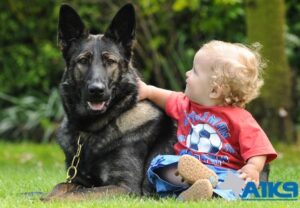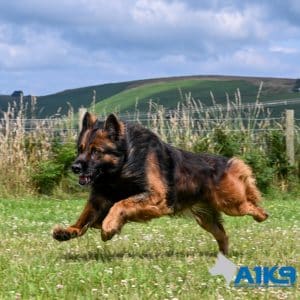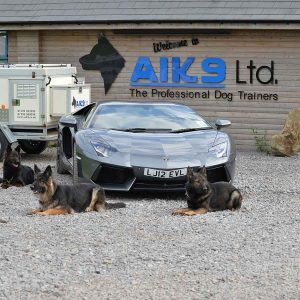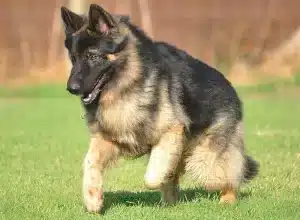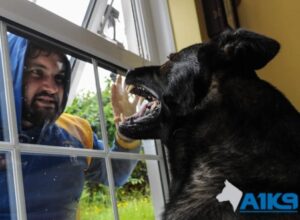Here at A1K9, we’re proud of what we do and the dogs we train. Our time proven methods produce outstanding personal protection dogs that excel in a family environment. A core part of this process is the consistent, balanced, training techniques we’ve developed over our decades of experience. In our newest YouTube series, we aim to show you an inside look into what we do here at A1K9.
Our services include a range of dog training solutions and courses for both the protection dogs we train and supply a variety of courses for dog owners looking to address problems that they may be experiencing with their canine companions. Our residential obedience training course is popular for those who would like to enlist our help in training their dogs but are not based close to our facilities. We see a steady stream of dogs joining our programme from across the entire UK and occasionally from Europe too.
Furthermore, we also offer a full complement of very well-subscribed classes to those in the local community, ranging from puppy classes right through to the platinum obedience class.
Obedience and control are at the core of dog training and make up the foundations for all other more specialised training that may follow. No matter the breed, size of the dog or the situation, these foundational skills are vital in ensuring your dog is balanced, well-mannered and under control.
The Training Process: Obedience and Control Exercises
Part 1 in our YouTube series delves into the training process at a basic level and offers an overview of how it all works here at A1K9. Our staff work extremely closely with the dogs they handle and train. This helps them build a relationship and allows the dog to become familiar with responding to commands from this person with whom they have both a relationship and a bond.
Training always starts on an individual basis to get the dogs full attention and focus on the trainer and the current sessions aims. Soon after this, depending on how quickly the dog accepts and picks up the training, we typically do a lot of group training alongside any specific individual exercises. This is important as it brings natural distractions into a dog’s training regime, which is more realistic and closer to a real-life park scenario.
By working the dogs together, they have each other as a potential distraction as well as other staff members. This puts more pressure on the dog to remain focused and increases its concentration capacity during each session, despite adding the distractions.
As well as basic obedience exercises, which we encourage all owners to regularly run through, our team train the dogs, gradually increasing the duration for which they stay on task and increasing the difficulty of each task, possibly by making it more complicated, distracting or both, thus proofing the dogs training. An example seen within the video is when the weave exercise is altered with the dogs themselves acting as stationary ‘poles’ – making the task doubly challenging!

Honing a Skill
Throughout the video, you may notice little mistakes that have been corrected by the dog’s handler. These moments have been purposefully left in to show you the real, raw truth of the dog training process. Much like people, dogs cannot be perfect 100% of the time. This is why it’s so vital to have their trainers ready to step in and correct a mistake, allowing the dogs to learn and grow, becoming the best version of themselves they can be, while still retaining their character.
Rather than faultless, over-edited dog training, you may see a dog turn the wrong way, move a bit out of position, sit instead of stand, or in the case of the still very young Jinn, rollover instead of lying down! Where deemed necessary these are corrected, but if the core skill being tested is the ability to stay in one spot over distance and time, then the position is a secondary aspect.
You will also see the absolute focus and dedication that these dogs have to their trainers. In the case of Moon and Adam, the Malinois always has her eyes and attention firmly on her trainer Adam. She is clearly happy, receiving praise, and enjoying her training whilst improving all the while – as it should be!
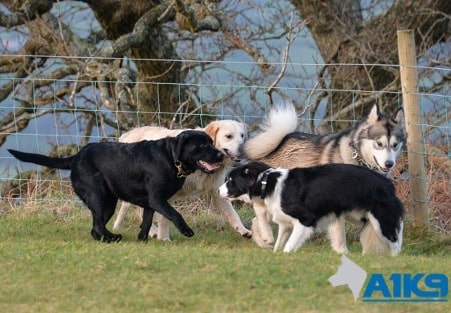
A Variety of Environments
As the video acts as an overview of what we do and the dog training process here at A1K9 we thought it important to see progress on many different levels in a range of situations. For this reason, we have selected a range of dogs and trainers, from those who are quite far through their training to newer dogs. Plus, we even had a few children helping, with an 8- and 9-year-old handling and working with the dogs during the summer holidays.
Furthermore, we use the land at our disposal here at A1K9 to take the opportunity to train these future protection dogs in different locations across our own property. We also take the dogs into town and city environments to ensure they are well accustomed to the business of daily life. This variety in their training environment is vital, as it means the dog’s training won’t become area specific. By varying their training experiences, they will remember and utilise their training irrespective of the environment they are in.
Ultimately, these dogs will live within family homes and will be on hand to shield and protect the family members, the home, and the assets of the family. As the dog goes through their future life, the likelihood of using its protection skills is hopefully remote but obedience is likely to be an expected requirement on a day-to-day basis. Therefore, we train and condition them over a long period of time, so as to ingrain the desired traits to ensure these dogs are loving, family pets that are exceptionally well-behaved, and trained only to protect when needed. This level of commitment to training allows all members of the family to have confidence handling and interacting with their A1K9 protection dog, which is ultimately a very highly trained family pet and companion with a special set of skills.
How Long Does Training and Obedience Work Take?
How long a dog will stay in training at A1K9 is dependent on several factors, including the breed and age of a dog, as well as how far they’ve progressed up until now. If a dog is more used to training, it’ll be able to progress much faster than a new dog. This is because we will only train a dog if it is engaged and having fun. The time this mindset lasts will vary for each dog but will likely be longer for those that are building on previous training. Once the dog has disengaged from the session there is little point in continuing, so we always ensure to finish each session on a positive note before this point. This is a key principle of dog training and for good reason.
Building Daily Practice into Your Routine
Practice makes perfect, especially when working with dogs. Their obedience training should be built in as an instant response and is vital for demonstrating that your dog is under full and proper control, obeying commands at any time, in any situation. Therefore, this training should be an ongoing process, even after a dog leaves us.
We would recommend wherever possible that owners implement at least 5-10 minutes each day into maintaining these training foundations in a dog’s daily routine. Even just practising basic obedience commands each day can go a long way.
Some examples of standard obedience commands that should be consistently practised are:
- Recall
- Walk to heel
- Sit
- Lie down
- Stay – both standing, sitting, lying down, and at a distance

Strong Foundations for Your Family Protection Dog
Obedience and control are the core principles of foundational dog training, with many considering a dog’s level in these basic but essential skills a representative of their general behaviour and protection abilities. The more you practice, the better the dog will become, and the more in tune you will become with the dog.
Find out more and see our dogs in action in Part 1 of our new YouTube Series. Part 2 will put the spotlight on our protection work and our available residential obedience programmes. Plus, we’ll get to see more of how our family protection dogs perform around children.

